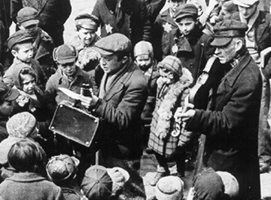How can a person, subjected to the most inhumane conditions imaginable, hold onto their humanity? For Jews of the Holocaust, one way was creating music. In the ghettos, concentration camps and even death camps, music of all types emerged, from classical instrumentals to folk tunes; children’s songs; resistance songs; and songs of sadness and despair that today provide important windows into the prisoners’ experiences. Their music lives on at Music and the Holocaust, the world’s largest archive of its kind.
Hosted by Jewish Federation partner World ORT, the online archive is a trove of information, with hours of audio and video clips, details on the musical culture of specific ghettos and camps, and biographies of hundreds of composers. Like the story of Dovid Beyglman, who maintained an essential piece of himself by composing prolifically within the Lodz ghetto — including “Gypsy Song,” about the suffering of the Roma also interned there — and directed an 18-person ensemble, choir and dance group on the ghetto stage. When Dovid was transported to Auschwitz, where he would be murdered, he took his violin with him.
“People ask me, ‘Why do you want to be involved with this tragic music all day?’” says co-curator Clive Marks, former chair of the London College of Music and London School of Jewish studies. “But I find it inspiring that it was composed against such long odds.”
Through those compositions we can travel back through time, so that we may Never Forget. From the Lodz ghetto you can listen to the mournful and furious “Does It Have to Be This Way?”; from Vilna, a rousing ode to an underground resistance leader after his capture by the Gestapo; and from Treblinka, hauntingly, “Lullaby for My Little Boy in the Crematorium” — a song so heartbreaking as to make a listener grateful for the warble of surviving Polish children in postwar France singing “Heveti Shalom Alykhem.”



